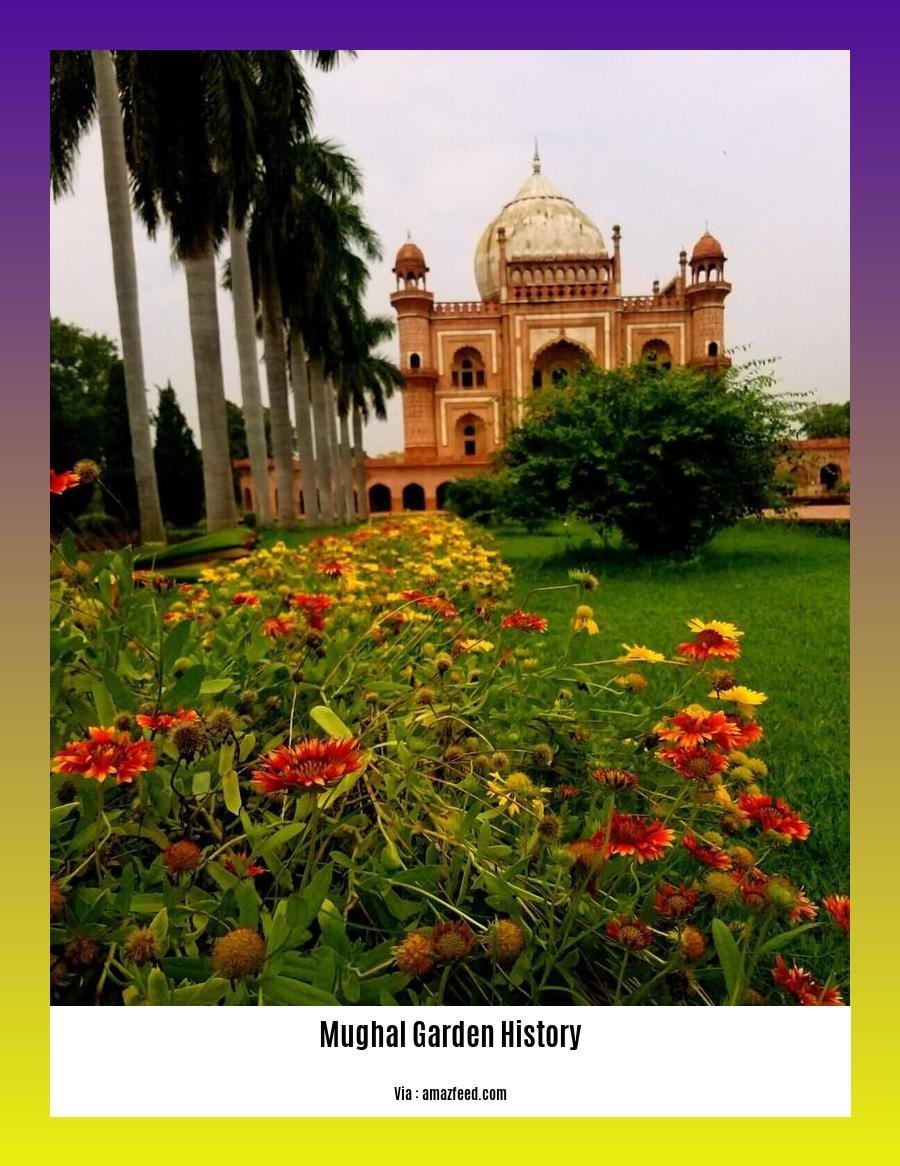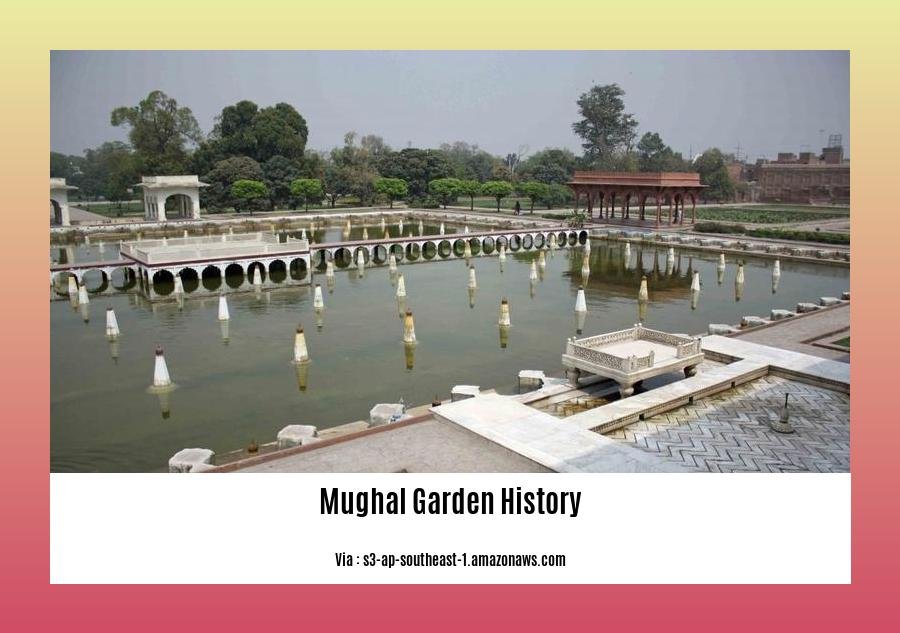Embark on a historical journey to uncover the rich tapestry of Mughal Garden History. We’ll explore the captivating designs, symbolic meanings, and historical significance of these architectural marvels, providing a comprehensive narrative about their evolution and legacy.
Key Takeaways: Unveiling the Rich Tapestry of Mughal Garden History
- Mughal Gardens, built by the Mughal Empire from the 16th to 19th centuries, drew inspiration from Persian gardens.
- Gardens represented earthly paradise, with four quadrants symbolizing earth, water, air, and fire.
- Fountains, pools, and fruit trees adorned these gardens.
- Gardens provided both practical benefits (respite from heat) and aesthetic enjoyment (relaxation and contemplation).
Mughal Garden History

The Mughal Gardens are an exquisite tapestry of architectural and historical significance, a testament to the artistic brilliance of the Mughal emperors who ruled India from the 16th to 19th centuries.
Origins and Influences
Mughal Gardens trace their roots to Persian gardens, where they were designed to represent an earthly paradise, a concept known as charbagh. These gardens were typically divided into four quadrants, each symbolizing an element: earth, water, air, and fire.
Design Features
Mughal Gardens showcased a harmonious blend of aesthetic and functional elements:
- Formal Layout: Divided into geometric quadrants, often with a central water channel or fountain.
- Symmetry and Balance: Gardens were often symmetrical, with symmetrical walkways, pools, and pavilions.
- Water Features: Water played a significant role, with fountains, pools, and canals providing a sense of tranquility and coolness.
- Flora: Gardens were adorned with lush vegetation, including fruit trees, flowers, and aromatic plants.
- Architectural Elements: Gardens incorporated pavilions, kiosks, and terraces, providing spaces for relaxation and contemplation.
Historical Significance
Mughal Gardens were more than just beautiful landscapes; they served practical and symbolic purposes:
- Retreats: The gardens provided a tranquil escape from the heat and bustle of city life.
- Aesthetic Delight: They were designed to stimulate the senses and evoke a sense of wonder and awe.
- Cultural Symbolism: Gardens held cultural significance, representing the fusion of Islamic, Persian, and Indian architectural influences.
Examples of Notable Gardens
Among the most famous Mughal Gardens are:
- Gardens of Shalimar, Lahore: A UNESCO World Heritage site renowned for its exquisite water features and lush greenery.
- Taj Mahal Gardens, Agra: Adjoining the iconic Taj Mahal, these gardens are a testament to the Mughal emperors’ love of nature and aesthetics.
- Nizamuddin Dargah Gardens, Delhi: Located around the shrine of Nizamuddin Auliya, these gardens offer a serene retreat within the bustling city.
Mughal Gardens stand as a testament to the artistic genius of the Mughal Empire, showcasing their architectural prowess and their profound appreciation for the natural world.
Discover the fascinating reigns of the Mughal Empire by delving into the History Of Mughals. Uncover the rich heritage and significant contributions of one of India’s most prominent dynasties.
Explore the captivating story of Mughalsarai, a crucial railway junction in India. Read the History Of Mughalsarai to learn about its historical significance and its role in shaping the nation’s transportation network.
Symbolic Meanings and Cultural Significance

Mughal Gardens, inspired by Persian gardens, were meticulously planned to manifest an earthly paradise, a charbagh in Persian. These gardens were imbued with profound symbolic meanings and cultural significance.
Water as Life and Purity
Fountains, pools, and canals were essential features, symbolizing the life-giving force of water. They also represented purity and renewal, inviting visitors to cleanse both physically and spiritually.
Lush Vegetation for Abundance and Prosperity
Fruit trees, flowers, and aromatic plants adorned these gardens, representing abundance and prosperity. The scent of fragrant flowers was believed to uplift spirits and create a serene atmosphere.
Architectural Elements for Harmony
Pavilions, kiosks, and terraces added architectural elements, symbolizing human ingenuity and harmony between nature and the built environment. They provided shaded spaces for relaxation and contemplation.
Key Takeaways:
- Mughal Gardens were designed to reflect an earthly utopia.
- Water symbolized life and purity.
- Lush vegetation represented abundance and prosperity.
- Architectural elements fostered harmony between nature and humans.
Sources:
Mughal Gardens
The Mughal Garden
Evolution of Mughal Gardens Over Time
Picture a world of vibrant gardens, a testament to the Mughal Empire’s grandeur and love for nature. These gardens weren’t just ornamental; they were symbols of power, harmony, and a celebration of life. Let’s dive into the fascinating story of how Mughal Gardens evolved over time.
The Persian Roots
The Mughals’ passion for gardens stemmed from Persian influences. Their gardens resembled earthly paradises, with flowing water and lush greenery. The concept of Charbagh, a quadripartite garden divided into four quadrants, became the foundation of Mughal garden design. Each quadrant symbolized an element of nature: earth, water, air, and fire.
Babur’s Charbagh and Akbar’s Refinement
Babur, the founder of the Mughal Empire, introduced the Charbagh concept to India. His garden in Agra, the Aram Bagh, was the first of its kind in South Asia. Akbar, his grandson, expanded and refined the Charbagh design, adding geometric patterns, marble fountains, and exotic plants.
Jahangir’s Water Features and Shah Jahan’s Legacy
Jahangir’s reign saw a focus on water features. Gardens flourished with cascading fountains, canals, and pools. Shah Jahan, often regarded as the pinnacle of Mughal architecture, created the iconic Taj Mahal Gardens. These gardens showcased the empire’s horticultural brilliance, with intricate parterres, marble walkways, and towering cypress trees.
Key Takeaways:
- Mughal Gardens evolved from Persian garden design, with a focus on symmetry and water features.
- Each Mughal emperor contributed unique elements to garden design, from Babur’s Charbagh layout to Shah Jahan’s grandeur.
- Mughal Gardens symbolized power, harmony, and a love for nature.
Sources:
Legacy and Impact on Indian Architecture
Mughal architecture left an indelible mark on Indian architecture. Its distinctive elements, like red sandstone, white marble, intricate carvings, and towering domes and minarets, became integral to the architectural landscape.
Let’s explore the profound legacy of these architectural marvels:
Evolution of Mughal Gardens
Mughal gardens emerged from Persian and Islamic influences, combining geometry, water, and greenery. They evolved over time, reflecting the tastes of different emperors:
- Babur favored the Persian “charbagh” style, with four quadrants representing the elements.
- Akbar expanded the charbagh concept, adding elaborate water features and manicured lawns.
- Jahangir’s gardens showcased white marble and intricately inlaid pietra dura.
- Shah Jahan’s Taj Mahal Gardens epitomized Mughal garden design, with cascading pools and terraced landscapes.
Key Takeaways:
- Mughal gardens blended Persian and Islamic aesthetics with Indian influences.
- They symbolized Mughal wealth and power, while also providing relaxation and income.
- Key features included geometric layouts, water features, diverse plants, and architectural elements.
- Famous Mughal gardens include the Taj Mahal Gardens, Nishat Bagh, and Shalamar Gardens.
- Their impact on Indian architecture endures in buildings, palaces, and gardens across the subcontinent.














